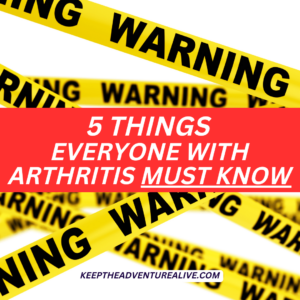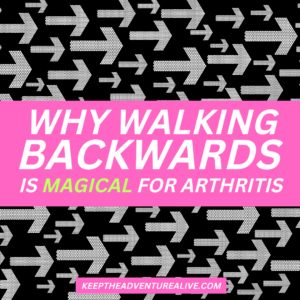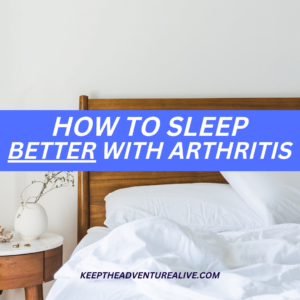Lateral hip pain is common, especially in women over 40 due to anatomical changes when compared to men as well as potential muscle imbalances that may be present. Does lateral hip pain mean you have hip arthritis? The short answer is no. But making sure your hips are strong and healthy can help to fend off osteoarthritis. In this article you’ll learn about the symptoms of lateral hip pain, what it might be, and how to find relief.
This article may contain affiliate links that provide us with a small compensation without any extra cost to you if products are purchased through these links.
Is lateral hip pain a sign of arthritis?
In short the answer is no, pain on the outside of your hip does not automatically mean you have hip arthritis. It is possible though that they exist together.
Here are are list of symptoms of each condition to help you get a better picture of what you may be dealing with.
Common symptoms of hip osteoarthritis:
- stiffness in the morning typically relieved after 30 minutes of movement
- groin pain
- pain with walking
- stiffness after being in one position for >15-20 minutes
- loss of range of motion
- pain when standing on one leg
(find out more about what osteoarthritis typically feels like in this post)
Common symptoms of lateral hip pain:
- pain when lying directly on it
- pain with walking and with stairs
- pain crossing your legs in sitting or standing
- potential presence of lower back pain
- pain when standing on one leg
Now we’ve differentiated these conditions a bit, if you have been experiencing at least one or all of the symptoms of lateral hip pain, keep reading!
If you find yourself in the category of hip osteoarthritis, you can find more helpful info here.
Please note this is not an exclusive list of symptoms and other symptoms may be present. If you are experiencing numbness/tingling, deep dull ache especially at night, unrelenting symptoms no matter your position or systemic symptoms like fever, fatigue, etc- please go to a medical professional for a full exam.
What causes lateral hip pain?
There can be many different causes of lateral hip pain. The most common type of pain is caused by what is a called “gluteal tendinopathy”.
This condition used to be labeled as “trochanteric bursitis” but according to the research “While this condition has traditionally been referred to as trochanteric bursitis, gluteus medius and/or minimus tendinopathy is now accepted as the most prevalent pathology in those with pain and tenderness over the greater trochanter [your outermost hip bone]” (Grimaldi an Fearon 2015).
What this really means is that one of your 3 layers of gluteal muscles are angry where they attach at the hip.
See in the picture below the outermost layer known as the gluteus maximus. Underneath that large muscle are two other smaller layers. Each layer is responsible for a different movement of the leg.
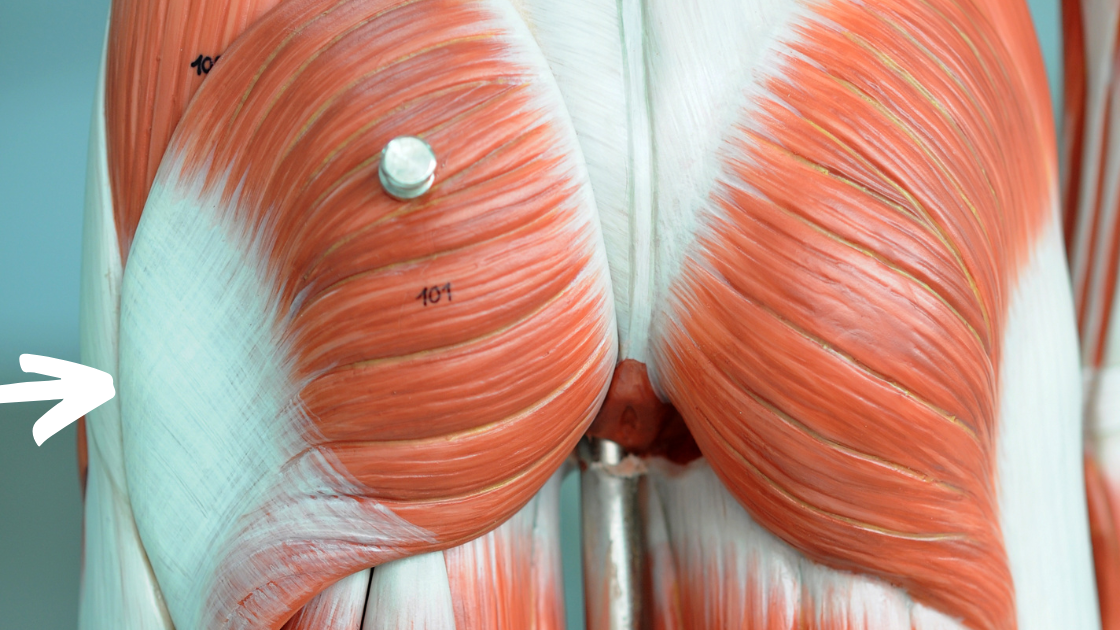
This could be caused by:
- muscle weakness
- hip angle (most common in women)
- overuse
- recent sharp increase in activity
If you think about your recent activity- the recent sharp increase in activity seems to be one of the primary aggravators.
Did you recently walk/hike/run significantly more than normal?
Did you climb more stairs than you usually do, say on vacation or maybe even doing housework, cleaning or running errands?
If you answered yes, this type of tendinopathy may be the culprit.
So now what?
What are the best treatment options for someone experiencing gluteal tendinopathy and lateral hip pain?
In a systematic review completed in 2021 for the Orthopedic Journal of Sports Medicine, different treatment options were explored. Exercise has been found to have an effect on pain levels in the earlier stages of this condition.
"Mellor et al investigated the effect of an exercise program (initial educating session, followed by 14 individual sessions over 8 weeks with a registered physical therapist) on hip pain intensity and patient satisfaction measured using the global rating of change scale. Greater total improvement and lower pain intensity were found 8 weeks after initial treatment for gluteal tendinopathy compared with a single CSI [corticosteroid injection] at baseline or a wait-and-see approach"
Ladurner et al, 2021
In a clinical commentary in the Journal of Orthopedic & Sports Physical Therapy, Grimaldi and Fearon discuss the primary, conservative treatments to include:
- avoiding movements and positions that place the greatest stress on the painful area of the hip
- beginning with light isometrics (a special type of exercise shown to help with tendon pain relief)
- progressing to resistance movements to load the tendon appropriately
Let’s break this down further.
Movements to avoid
With higher levels of lateral hip pain, some movements to avoid include positions that strain the glute muscle(s).
One of the most aggravating positions that has been found is called hip adduction which is illustrated in each of the pictures below.
Hip adduction occurs when the leg is moved towards the opposite side of the body.
In the second photo from the left, you’ll see a graphic depiction of the hip joint.
As you can see, leaning on your hip causes adduction of the hip you’re leaning towards.
These positions can actually aggravate the tendon and increase lateral hip pain. This is because there is a point on your hip called the greater trochanter that the irritated muscle comes in contact with.
Without lateral hip pain, adduction shouldn’t pose an issue. But if the gluteal tendon(s) is/are irritated rubbing over that may not feel great.
This is also where trochanteric bursitis got its name as it was once proposed that the bursa (a fluid filled sac) got irritated. It has been proposed that bursitis isn’t as common as once thought. “[A] recent imaging study 60 of 877 individuals with greater trochanteric pain demonstrated a similar low incidence of bursal change, with only 20% exhibiting bursal thickening on ultrasound” (Grimaldi and Fearon 2015).
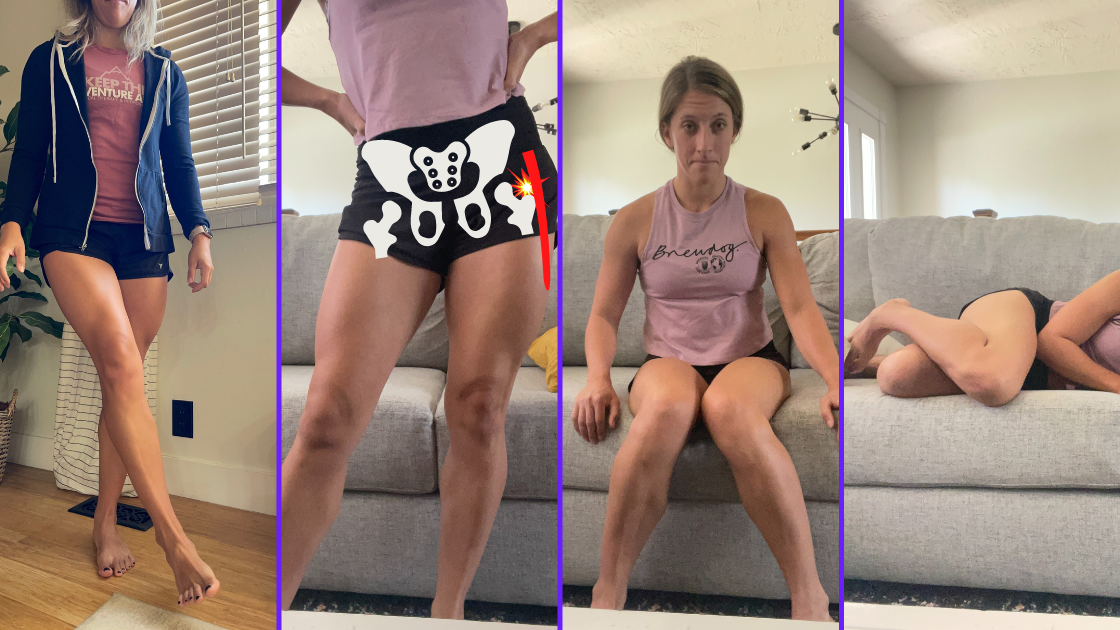
Movements such as crossing your legs, leaning to one side, bringing your knees together, side lying without pillow support can be aggravating and should be avoided when experiencing high levels of lateral hip pain in attempts to decrease irritation.
Sleeping with a pillow between your legs may be helpful but when sleeping it may feel better to try laying on your back so you aren’t putting pressure on the lateral hip area.
Exercises for lateral hip pain
Starting out with light exercise is the best way to start to reintroduce movement and decrease irritation. Starting out too intense may continue to flare up your pain. Progress as you are able, as pain reduces.
1. Isometric Hip Abduction:
For this movement you can start without a resistance band and make sure it feels okay. After 5-10 reps if you don’t experience an exacerbation of lateral hip pain, grab a resistance band, like these.
Watch the video below for more details on how to complete this movement.
Isometrics are a type of exercise where you hold and contract your muscles without actively moving.
You will take your legs apart as far as is comfortable then hold for up to 30-45 seconds. Start with a lower amount of time to make sure no pain occurs (preferably 10-15 seconds).
2. Standing Hip Abduction
Side stepping can be the next step as you notice you don’t allow your knee to move past the midline of your body into excessive adduction.
Incorporating 30-60 seconds of side stepping might be a great place to start but this will definitely depend on your symptoms and level of pain. Use support if needed.
3. Banded side slides
Start with a lighter band and use support if needed. This is one way to work both the muscles on the outer hips and the inside thighs without aggravating lateral hip pain.
If you do experience lateral hip pain with this, the resistance may be too much or the range of motion may be too far. Try modifying those factors to see if pain reduces. If not, revert back to an earlier exercise in this post.
Complete up to 15 repetitions 2-3 times per week and see how your pain responds. At this point, pain should be pretty well relieved. Watching for pain afterwards is also very important and may indicate your muscle isn’t quite ready for this exercise.
Keeping Hips Healthy
Lateral hip pain may present with hip osteoarthritis but there are certain considerations for lateral hip pain you must be aware of.
Being aware of how you are sitting and standing can help to relieve pressure on the tendons that are most sensitive.
Keeping this in mind, if you have accompanying hip, knee, ankle, or lower back pain/arthritis, I have created a FREE 3 Day Walking Workout Challenge that is arthritis friendly. You’ll gain access to 3 follow along workouts showing you the best ways to build strength, balance and stamina so you can walk with ease.
Once you have calmed down your symptoms, this would be a great next step.
Consistency with movement is key to keeping your joints healthy! Can’t wait to see you inside the challenge.
References
Alyssa Kuhn

If you are looking to regain your active life but are unsure where to start, join the revolutionary membership, Adventurers for Life. This is a step-by-step path that not only will help you find pain relief but will help you unlock adventure. You’ll get workouts, tests to pass to make sure you are on the right track, community events and MORE.
Disclaimer: This post is for general informational purposes only. It should not be used to self-diagnose and it is not a substitute for a medical exam, cure, treatment, diagnosis, and prescription or recommendation. It does not create a doctor-patient relationship between Dr. Kuhn and you. You should not make any change in your health regimen or diet before first consulting a physician and obtaining a medical exam, diagnosis, and recommendation. Move Well Age Well, LLC and Dr. Alyssa Kuhn, PT, DPT are not liable or responsible for any advice, course of treatment, diagnosis or any conclusions drawn, services or product you obtain through this post, video or site. Complete all exercises at your own risk.

